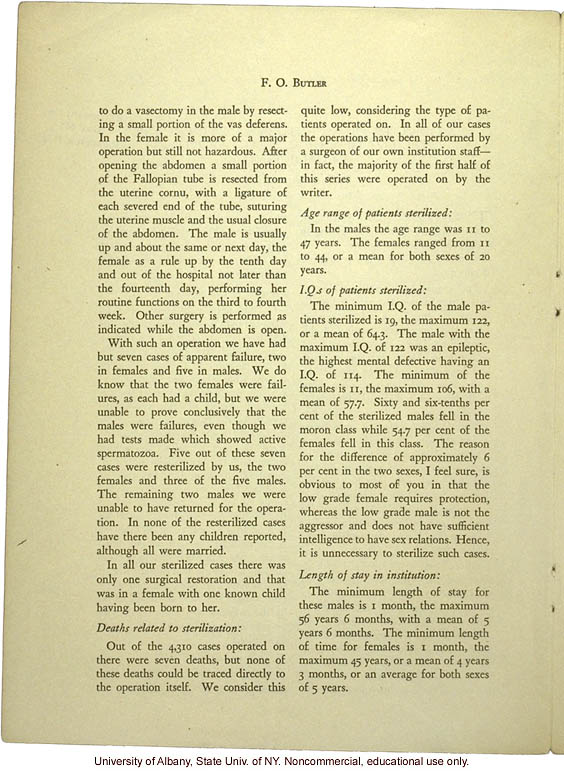F. O. Butler
to do a vasectomy in the male by resecting a small portion of the vas deferens. In the female it is more of a major operation but still not hazardous. After opening the abdomen a small portion of the Fallopian tube is resected from the uterine cornu, with a ligature of each severed end of the tube, suturing the uterine muscle and the usual closure of the abdomen. The male is usually up and about the same day, the female as a rule by the tenth day and out of the hospital not later than the fourteenth day, performing her routine functions on the third to fourth week. Other surgery is performed as indicated while the abdomen is still open.
With such an operation we have had but seven cases of apparent failure, two in females and five in males. We do know that the two females were failures, as each had a child, but we were unable to prove conclusively that the males were failures, even though we had tests made which showed active spermatozoa. Five out of these seven cases were resterilized by us, the two females and three of the five males. The remaining two males we were unable to have returned for the operation. In none of the resterilized cases have there been any children reported, although all were married.
In all our sterilized cases there was only one surgical restoration and that was in a female with one known child having been born to her.
Deaths related to sterilization:
Out of the 4,310 cases operated on there were seven deaths, but none of these deaths could be traced directly to the operation itself. We consider this quite low, considering the type of patients operated on. In all of our cases the operations have been performed by a surgeon of our own staff - in fact, the majority of the first half of this series were operated on by the writer.
Age range of patients sterilized:
In the males the age range was 11 to 47 years. The females ranged from 11 to 44, or a mean for both sexes of 20 years.
I.Q.s of patients sterilized:
The minimum I.Q. of the male patients sterilized is 19, the maximum 122, or a mean of 64.3. The male with the maximum I.Q. of 122 was an epileptic, the highest mental defective having an I.Q. of 114. The minimum of the females is 11, the maximum 106, with a mean of 57.7. Sixty and six-tenths per cent of the sterilized males fell in the moron class while 54.7 per cent of the females fell in this class. The reason for the difference of approximately 6 per cent in the two sexes, I feel sure, is obvious to most of you in that the low female requires protection, whereas the low grade male is not the aggressor and does not have sufficient intelligence to have sexual relations. Hence, it is unnecessary to sterilize such cases.
Length of stay in institution:
The minimum length of stay for males is 1 month, the maximum 56 years 6 months, with a mean of 5 years, 6 months. The minimum length of time for females is 1 month, the maximum 45 years, or a mean of 4 years 3 months, or an average for both sexes of 5 years.
[end]


